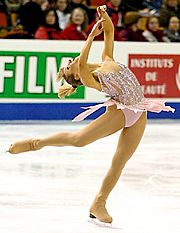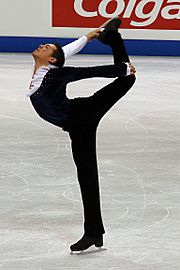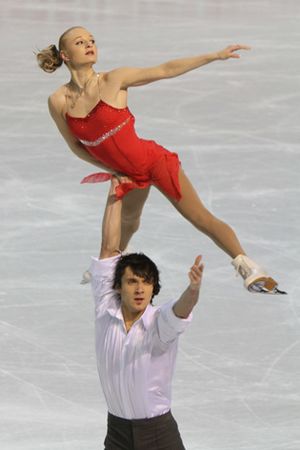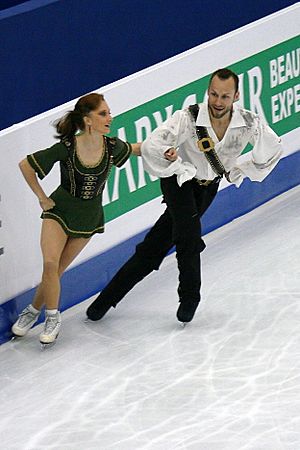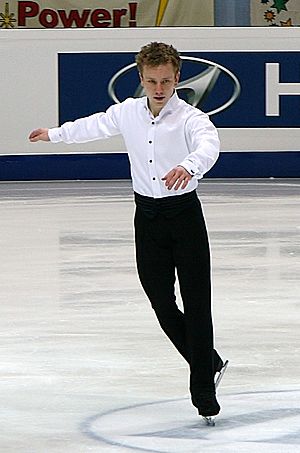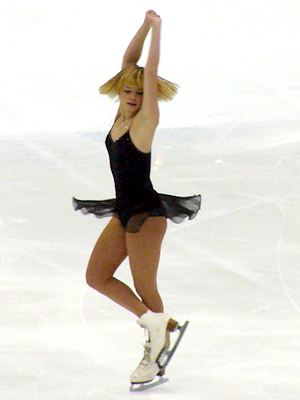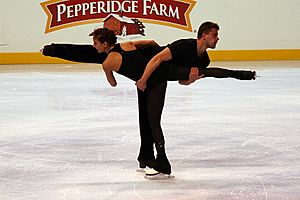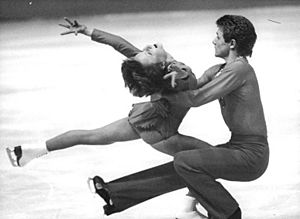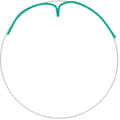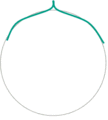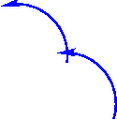Figure skating facts for kids
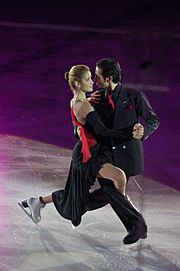
Figure skating is both an art and a sport, in which people skate around on ice, doing jumps and spins. It is done at the Winter Olympics, and it has its own world championships. The name means to make figures or patterns on the ice. People skate with music.
In figure skating, sometimes women or men skate alone, or they skate in couples. Couples dancing includes pairs and ice dancing. Pairs skating has jumps, and sometimes the man lifts the woman in the air. These things are not done in ice dancing. In ice dancing, the woman must be held in the man's arms. Another kind of figure skating is synchronized skating done in groups.
Contents
History
The first ever figure skating club was started in 1742 in Edinburgh, Scotland. World Championships began in 1896 (the first in St. Petersburg, Russia). Before the Winter Olympic Games were started, competitions in figure skating were part of the Summer Olympic Games, in 1908 and 1920.
Rules
The International Skating Union (ISU) make the rules.
Singles Skating
Singles skating is composed of a Short Program and a Free Skate. Both of them have a technical score and a presentation score.
- The Short Program (SP) must include 2 solo jumps, a jump combination consisting of two jumps, 3 spins and one Step Sequence fully utilizing the ice surface.
- Free Skate (FS) contains jump elements, jump combinations or jump sequences. The Free Skate also has 3 spins, one Step Sequence fully utilizing the ice surface and a choreographic sequence.
Judges
Under the ISU Judging System the Judges focus entirely on evaluating the quality of each element performed (technical aspect) and the quality of the performance. There will be a panel of 9 Judges per segment. Out of these 9 scores, the highest and lowest score of each element or program component are ignored and the average will be taken.
Technical Score
The score for the element is composed of a “Base Value” of each element and the “Grade of Execution - GOE”. GOE is that the Judge grades the quality of the element on a scale of +3, +2, +1, 0, -1, -2, -3. The total of all the elements scores gives the Technical Score.
Presentation Score
The Judges award points on a scale from 0.25 to 10,00 with increments of 0.25 for the Presentation Score to grade the overall presentation of the performance. There are five items in the Presentation Score.
Skating Skills
- Over all skating quality
Transitions, Linking Footwork and Movement
- The varied and/or intricate footwork, positions, movements, and holds that link all elements. This also includes the entrances and exits of technical elements.
Performance/Execution
- The physical and emotional involvement of the skater/couple as they translate the intent of the music and choreography
Choreography/Composition
- The arrangement of all movements according to the principles of proportion, space and music
Interpretation
- The translation of the music to movement on ice
Jumps
There are six types of jump that ISU decides to score. The following items are listed in order of the score (difficulty). There are two types of jumps: edge jump and toe jump. The Axel, loop, and Salchow are edge jumps and the lutz, flip and toe loop are toe jumps.
- Axel
- This is the only jump where a skater takes off while skating forward. It's the most difficult jump of the six.
- Lutz
- The skater takes off from the back outside edge of the left or right foot and pokes the ice with the opposite toe.
- Flip
- The skater takes off from the back inside edge of the left or right foot and pokes the ice with the opposite toe.
- Loop
- The skater takes off from the back outside edge of the right or left foot. This jump is often used in second jump of combination jump.
- Salchow
- The skater takes off from the back inside edge of the right or left foot.
- Toe Loop
- The skater takes off from the back outside edge of the right or left foot and pokes the ice with the opposite toe. This is the easiest jump and it is often used in second jump of combination jump.
Spins
Spins are classified as Sit spins, Upright spins or Camel spin. Each of them has various variations. Any position which is not basic is a non-basic position.
Sit spin
The position of this spin is that the upper part of the skating leg is at least parallel to the ice.
- there are 3 categories based on position of free leg
-
- Sit Forward (with leg forward)
- Sit Sideways (with leg sideways)
- Sit Behind (with the leg behind)
Upright spin
The position of this spin is any position with the skating leg is extended or slightly bent which is not a camel position.
- there are 4 categories based on position of the torso.
-
- Upright Forward (with torso leaning forward)
- Upright Straight or Sideways (with torso straight up or sideways)
- Upright Biellmann (in Biellmann position)
- Upright Layback
Camel spin
The position of this spin is any position where the free leg backwards and the knee is higher than the hip level, however Layback, Biellmann and similar variations are still considered upright spins.
- There are 3 categories based on the direction of the belly button.
-
- Camel Forward (with belly button facing forward)
- Camel Sideways (with belly button facing sideways)
- Camel Upward (with belly button facing upward)
Turns and Steps
- Turns
-
- three turns, twizzles, brackets, loops, counters, rockers
- Turns must be executed on one foot. If a turn is “jumped ”, it is not counted as performed.
- Steps
-
- toe steps, chasses, mohawks, choctaws, change of edge, cross rolls
- Steps must be executed on one foot whenever possible.
Related pages
Images for kids
-
An example of ice dance costumes (Tessa Virtue and Scott Moir at 2012 World Championships)
-
Jackson Haines is considered to have been the father of modern figure skating.
-
Russian pair skaters Ludmila Belousova and Oleg Protopopov in 1968
-
Takahiko Kozuka waiting for his marks with coach Nobuo Sato in the "Kiss and cry" area
-
Denis Ten sets up for a jump.
-
Pairs skaters Marissa Castelli and Simon Shnapir set up for a throw jump
-
Anabelle Langlois lands after performing a throw jump with Cody Hay.
See also
 In Spanish: Patinaje artístico sobre hielo para niños
In Spanish: Patinaje artístico sobre hielo para niños



